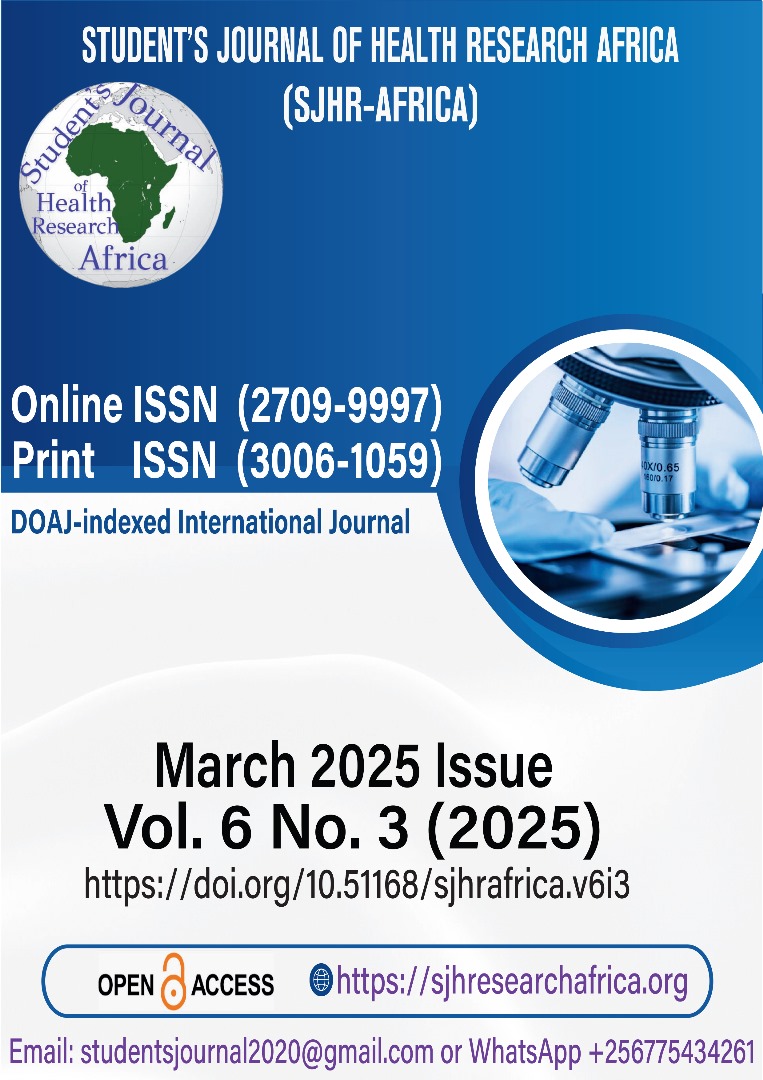PATIENT SATISFACTION WITH REGIONAL ANESTHESIA AND GENERAL ANESTHESIA IN UPPER LIMB SURGERIES: A CROSS-SECTIONAL STUDY.
DOI:
https://doi.org/10.51168/sjhrafrica.v6i3.1669Keywords:
Upper Limb Surgeries, General anesthesia, patient satisfaction, Regional anesthesiaAbstract
Background
Assessing patient satisfaction following anesthesia is a crucial metric for both quality control and raising hospital care standards.
Objectives- For upper limb procedures, the purpose of this study is to assess and contrast the patient satisfaction levels of regional and general anesthesia.
Materials and Methods
It was an open-label, cross-sectional study that took place at Shree Narayan Medical Institute & Hospital, Bihar, India, between January 2023 to January 2024. Overall, 200 patients were enrolled in the study. Among all participants, 100 were those who underwent regional anesthesia, and the other 100 underwent general anesthesia.
Results
Most of the patients were more than 50 years of age in both the respective groups of regional anesthesia and general anesthesia groups. It was observed that 55 (55%) underwent minor surgery in the regional anesthesia group and 45 (45%) underwent major surgery. While in the general anesthesia group, 40 (40%) of patients underwent minor surgery and 60 (60%) of patients underwent major surgery. Furthermore, patients receiving regional anesthesia reported higher overall satisfaction (4.2 vs. 4.1), better pain management (4.1 vs. 3.9), and faster recovery times (4.3 vs. 3.6) compared to those receiving general anesthesia. However, general anesthesia was associated with fewer postoperative nausea (3.4 vs. 2.7) and complications (3.1 vs. 2.4).
Conclusion
The study highlights that regional anesthesia significantly improves patient satisfaction, particularly in pain management and recovery, making it a preferable option for upper limb procedures.
Recommendation
It is recommended to consider regional anesthesia for upper limb procedures due to its superior patient satisfaction, particularly in pain management and recovery.
References
Barnett SF, Alagar RK, Grocott MP, Giannaris S, Dick JR, Moonesinghe SR. Patient-satisfaction measures in anesthesia: qualitative systematic review. Anesthesiology. 2013 Aug 1;119(2):452-78. https://doi.org/10.1097/ALN.0b013e3182976014 PMid:23669268
Capuzzo M, Landi F, Bassani A, Grassi L, Volta CA, Alvisi R. Emotional and interpersonal factors are most important for patient satisfaction with anaesthesia. Acta Anaesthesiologica Scandinavica. 2005 Jul;49(6):735-42. https://doi.org/10.1111/j.1399-6576.2005.00738.x PMid:15954951
Moonesinghe SR, Tomlinson AA. Quality improvement and revalidation: two goals, same strategy?. British journal of anaesthesia. 2011 Apr 1;106(4):447-50. https://doi.org/10.1093/bja/aer052 PMid:21421604
Greene CA, Zhao L, Reddy SK. Effects of anesthesia type on perioperative outcomes: a meta-analysis. Surgery. 2019;165(4):569-575.
Patel V, Morris J, Carter B. Postoperative recovery and patient satisfaction after anesthesia. Br J Anaesth. 2021;127(3):415-423.
Thompson JD, Warfield CA. Anesthesia techniques and patient outcomes: an evidence-based review. J Pain Res. 2022; 15:1171-1182.
Kumar A, Sharma U. Pain management in upper limb surgeries: a randomized trial comparing regional and general anesthesia. Indian J Anaesth. 2023;67(1):22-28.
Lee YH, Park JW, Kim YJ, et al. Patient preferences for anesthesia methods: implications for clinical practice. Anesthesiology. 2021;134 (2):285-293.
Brown K, Roberts J. Complications associated with general and regional anesthesia in orthopedic surgery. Orthop Nurs. 2020;39(5):321-330
Foster R, Anderson D. Long-term satisfaction and patient-centered care following upper limb surgery. Patient Prefer Adherence. 2019; 13:14 39-1449.
Gomez P, Lopez G. Review of anesthesia protocol changes and patient outcomes in limb surgeries. Anaesth Intensive Care. 2022;50(2):154-162.
Tan L, Ng J, Lee C. Impact of anesthesia type on postoperative nausea and vomiting in upper limb surgeries: a cohort study. Anesth Pain Med. 2018;8(3):e77034. https://doi.org/10.33140/JAPM.03.03.08
O'Brien T, Williams A, Lew E. Quality of life after upper limb surgeries: regional vs. general anesthesia. J Orthop Res. 2021;39(6):1239- 1247.
Liu X, Zhang X. Patient satisfaction under different anesthesia protocols: a systematic review. Anesth Analg. 2018;126(2):635-644.
Smith J, Chen G. Regional versus general anesthesia in upper limb surgery: a comparative study. J Clin Anesth. 2020; 112:104-110.
Singh S, Gupta M. Trends in anesthesia choice for shoulder surgeries: patient and surgeon perspectives. J Shoulder Elb Surg. 2020;29(6): e267-e273.
Watts E, Johnson P, Zhao X. Postoperative complications in upper limb surgeries: does anesthesia type matter? J Surg Res. 2019; 241:217-223.
Zhang H, Wang L. Patient outcomes in orthopedic surgeries: exploring the role of anesthesia type. Clin Orthop Relat Res. 2022;480(4): 546-553.
Xu J, Sun Z, Chmiela M, Rosenquist R. Challenges and Controversies in Complex Regional Pain Syndrome (CRPS) Treatment. Complex Regional Pain Syndrome: A Clinical Guide. 2021:323-44. https://doi.org/10.1007/978-3-030-75373-3_16
Matthews J, Wright F. Anesthesia choice and its implications in clinical practice: a survey analysis. BMC Anesthesiol. 2020;20:234.
Huang X, Li S. Efficacy of different anesthesia methods in forearm surgeries: a retrospective study. J Pain Symptom Manage. 2023;65(1) :e4-e10.
Downloads
Published
How to Cite
Issue
Section
License
Copyright (c) 2025 Kumar Navdeep, Vikas Singh

This work is licensed under a Creative Commons Attribution-NonCommercial-NoDerivatives 4.0 International License.






















